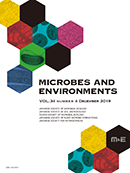Volume 35, Issue 4
Displaying 1-15 of 15 articles from this issue
- |<
- <
- 1
- >
- >|
Short Communication
-
Article type: Short Communication
2020Volume 35Issue 4 Article ID: ME20100
Published: 2020
Released on J-STAGE: December 05, 2020
Download PDF (495K) Full view HTML
Regular Paper
-
Article type: Regular Paper
2020Volume 35Issue 4 Article ID: ME20085
Published: 2020
Released on J-STAGE: December 05, 2020
Download PDF (472K) Full view HTML
Short Communication
-
Article type: Short Communication
2020Volume 35Issue 4 Article ID: ME20112
Published: 2020
Released on J-STAGE: December 02, 2020
Download PDF (1840K) Full view HTML
Regular Paper
-
Article type: Regular Paper
2020Volume 35Issue 4 Article ID: ME20107
Published: 2020
Released on J-STAGE: November 11, 2020
Download PDF (7760K) Full view HTML
Regular Paper
-
Article type: Regular Paper
2020Volume 35Issue 4 Article ID: ME20031
Published: 2020
Released on J-STAGE: November 07, 2020
Download PDF (940K) Full view HTML
Regular Paper
-
Article type: Regular Paper
2020Volume 35Issue 4 Article ID: ME20056
Published: 2020
Released on J-STAGE: November 07, 2020
Download PDF (2691K) Full view HTML
Regular Paper
-
Article type: Regular Paper
2020Volume 35Issue 4 Article ID: ME20114
Published: 2020
Released on J-STAGE: November 07, 2020
Download PDF (1673K) Full view HTML
Regular Paper
-
Article type: Regular Paper
2020Volume 35Issue 4 Article ID: ME20086
Published: 2020
Released on J-STAGE: October 24, 2020
Download PDF (510K) Full view HTML
Short Communication
-
Article type: Short Communication
2020Volume 35Issue 4 Article ID: ME20101
Published: 2020
Released on J-STAGE: October 22, 2020
Download PDF (2005K) Full view HTML
Regular Paper
-
Article type: Regular Paper
2020Volume 35Issue 4 Article ID: ME20106
Published: 2020
Released on J-STAGE: October 22, 2020
Download PDF (1496K) Full view HTML
Regular Paper
-
Article type: Regular Paper
2020Volume 35Issue 4 Article ID: ME20069
Published: 2020
Released on J-STAGE: October 06, 2020
Download PDF (569K) Full view HTML
Regular Paper
-
Article type: Regular Paper
2020Volume 35Issue 4 Article ID: ME20078
Published: 2020
Released on J-STAGE: October 02, 2020
Download PDF (985K) Full view HTML
Regular Paper
-
Article type: Regular Paper
2020Volume 35Issue 4 Article ID: ME20093
Published: 2020
Released on J-STAGE: September 19, 2020
Download PDF (1598K) Full view HTML
Regular Paper
-
Article type: Regular Paper
2020Volume 35Issue 4 Article ID: ME20052
Published: 2020
Released on J-STAGE: September 19, 2020
Download PDF (1289K) Full view HTML
Regular Paper
-
Article type: Regular Paper
2020Volume 35Issue 4 Article ID: ME20046
Published: 2020
Released on J-STAGE: September 18, 2020
Download PDF (804K) Full view HTML
- |<
- <
- 1
- >
- >|
